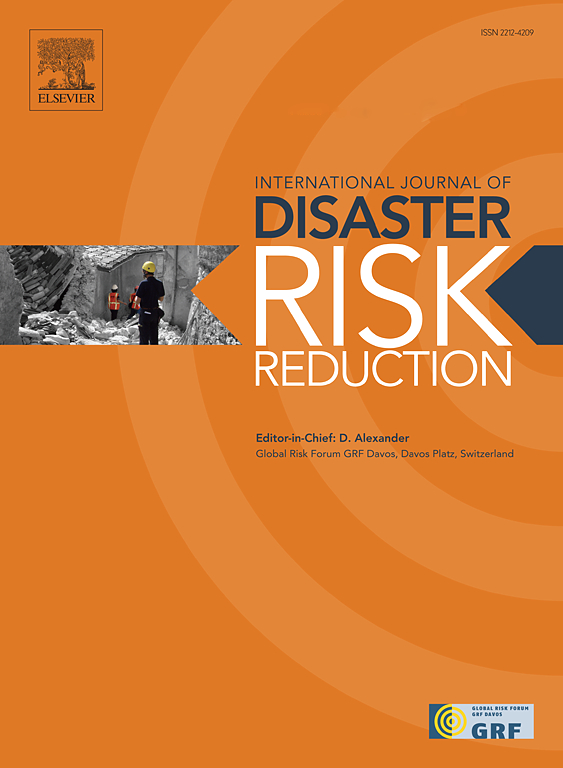Disaster risk reduction education (DRRE) in elementary education of Pakistan: Challenges and scaling up endeavours
IF 4.2
1区 地球科学
Q1 GEOSCIENCES, MULTIDISCIPLINARY
International journal of disaster risk reduction
Pub Date : 2024-11-01
DOI:10.1016/j.ijdrr.2024.104962
引用次数: 0
Abstract
Disaster Risk Reduction Education (DRRE) plays a crucial role in building community resilience by equipping children with the knowledge and skills needed to respond to disasters and reduce vulnerabilities. School children are not only among the most vulnerable to disaster impacts but also serve as important agents of change by sharing DRR knowledge with their families and communities. Over the past decade, educational initiatives in Pakistan have gained momentum to mitigate disaster-related damages and foster resilience. This approach has been supported by numerous studies highlighting its effectiveness in achieving positive results. This study examines the factors that can either aid or impede the expansion of disaster risk reduction education for primary school students in four districts of the Khyber Pakhtunkhwa Province. The study employed a multi-informant mixed-method approach that gathered data from multiple sources, including elementary school children, school personnel, and child-centered disaster risk reduction non-governmental organizations members. Many teachers in the study believed they could involve children in disaster preparedness and thought disaster risk reduction education should be taught in schools. The study identified six significant challenges (policy blueprint for DRR education, cognizance and availability of DRR educational materials, teacher’s competence to improve learning outcomes, strengthening school partnerships, allocating resources for optimal results, and giving children a voice) and proposed several policies recommendations for making progress. Although these issues may be prevalent in developing and developed nations, the suggested strategies may have applicability beyond the geographic confines of Khyber Pakhtunkhwa, Pakistan.
巴基斯坦初等教育中的减少灾害风险教育(DRRE):挑战和扩大规模的努力
减少灾害风险教育(DRRE)通过向儿童传授应对灾害和减少脆弱性所需的知识和技能,在建设社区抗灾能力方面发挥着至关重要的作用。在校儿童不仅是最容易受到灾害影响的群体之一,而且还通过与家人和社区分享减灾知识,成为推动变革的重要力量。在过去的十年中,巴基斯坦的教育举措在减轻灾害造成的损失和提高抗灾能力方面取得了进展。许多研究都强调了这种方法在取得积极成果方面的有效性。本研究探讨了有助于或阻碍开伯尔巴图克瓦省四个地区的小学生扩大减少灾害风险教育的因素。研究采用了多信息混合方法,从多个来源收集数据,包括小学生、学校工作人员和以儿童为中心的减少灾害风险非政府组织成员。研究中,许多教师认为他们可以让儿童参与备灾,并认为应在学校开展减少灾害风险教育。该研究确定了六大挑战(减灾教育的政策蓝图、减灾教育材料的认知和可用性、教师提高学习成果的能力、加强学校伙伴关系、分配资源以取得最佳效果以及让儿童发表意见),并提出了若干政策建议以取得进展。虽然这些问题可能在发展中国家和发达国家普遍存在,但所建议的战略可能超越巴基斯坦开伯尔巴图克瓦省的地理范围。
本文章由计算机程序翻译,如有差异,请以英文原文为准。
求助全文
约1分钟内获得全文
求助全文
来源期刊

International journal of disaster risk reduction
GEOSCIENCES, MULTIDISCIPLINARYMETEOROLOGY-METEOROLOGY & ATMOSPHERIC SCIENCES
CiteScore
8.70
自引率
18.00%
发文量
688
审稿时长
79 days
期刊介绍:
The International Journal of Disaster Risk Reduction (IJDRR) is the journal for researchers, policymakers and practitioners across diverse disciplines: earth sciences and their implications; environmental sciences; engineering; urban studies; geography; and the social sciences. IJDRR publishes fundamental and applied research, critical reviews, policy papers and case studies with a particular focus on multi-disciplinary research that aims to reduce the impact of natural, technological, social and intentional disasters. IJDRR stimulates exchange of ideas and knowledge transfer on disaster research, mitigation, adaptation, prevention and risk reduction at all geographical scales: local, national and international.
Key topics:-
-multifaceted disaster and cascading disasters
-the development of disaster risk reduction strategies and techniques
-discussion and development of effective warning and educational systems for risk management at all levels
-disasters associated with climate change
-vulnerability analysis and vulnerability trends
-emerging risks
-resilience against disasters.
The journal particularly encourages papers that approach risk from a multi-disciplinary perspective.
 求助内容:
求助内容: 应助结果提醒方式:
应助结果提醒方式:


